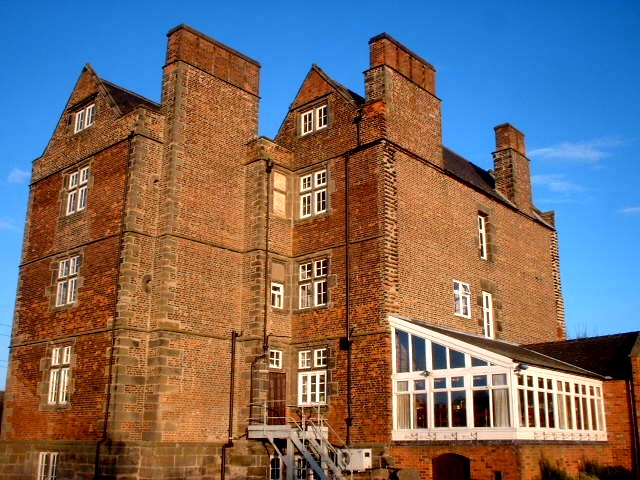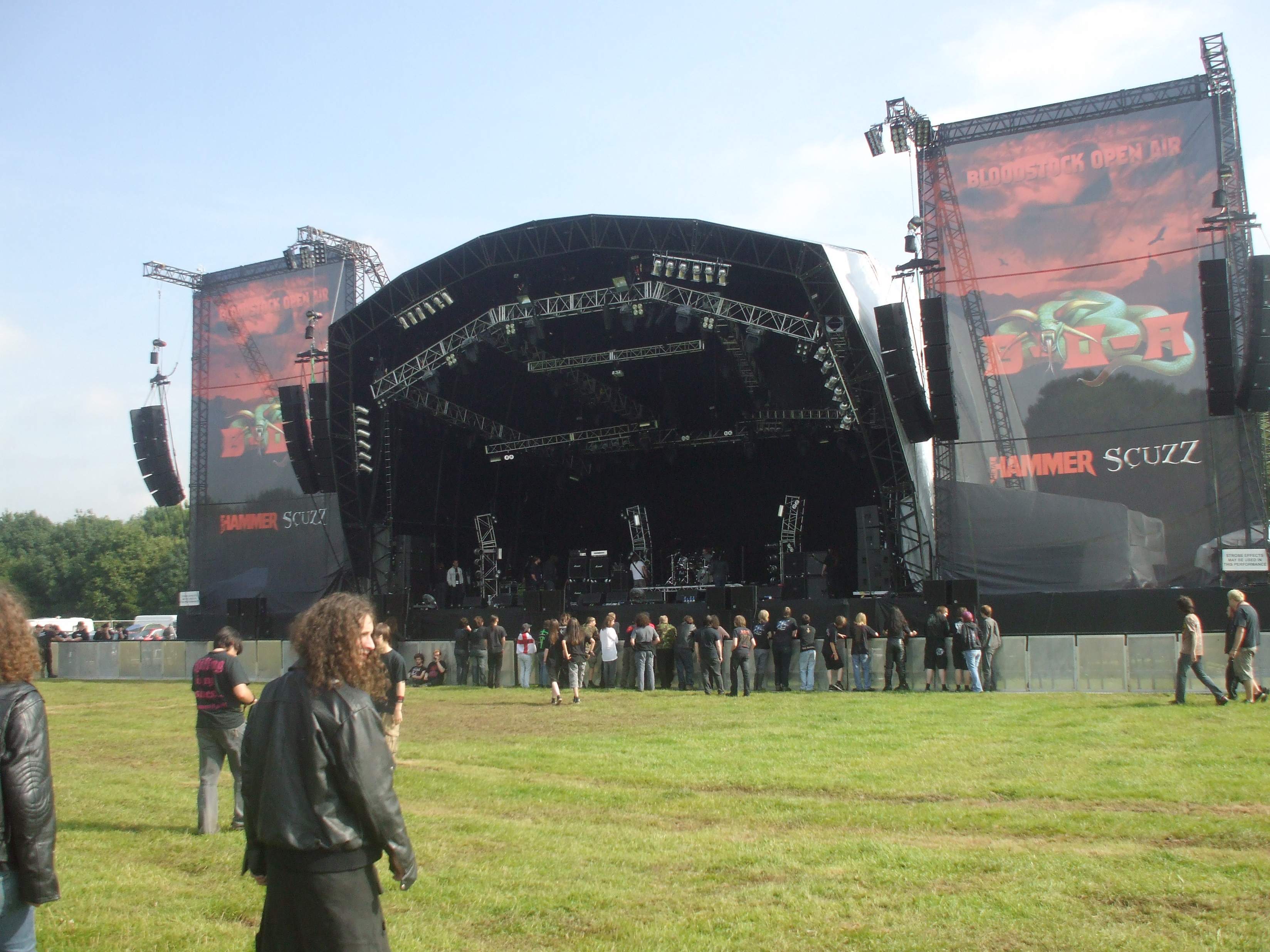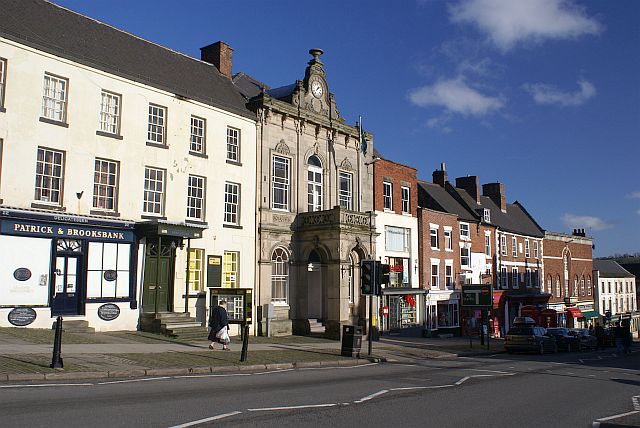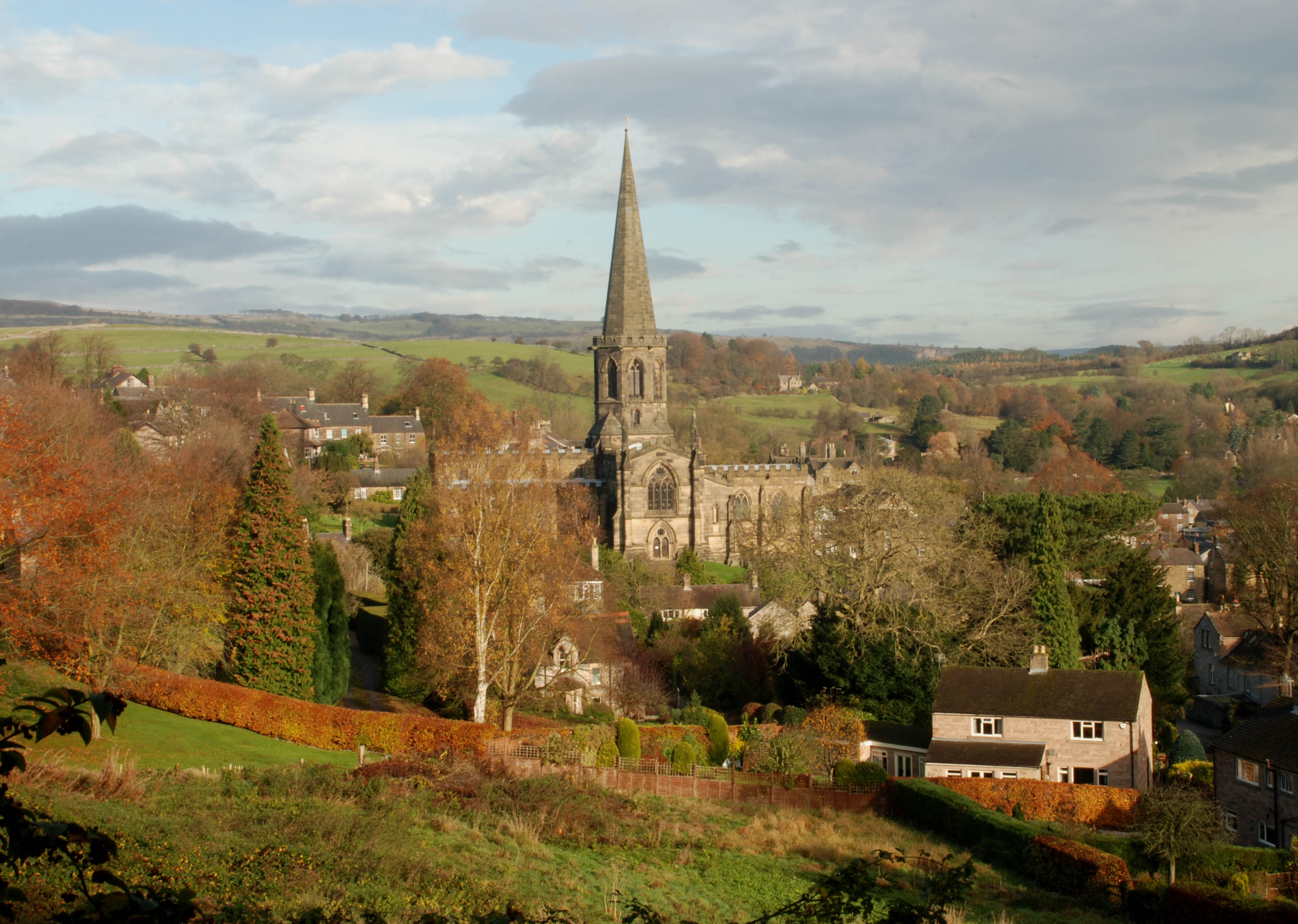|
Walton-upon-Trent
Walton-on-Trent is a village within the civil parish of Walton-upon-Trent, in the National Forest in the South Derbyshire district in Derbyshire, England. The population of the civil parish as taken at the 2011 Census was 872. The Bridge at Walton King Edward II crossed the river in pursuit of the disaffected barons including the Earl of Lancaster. Listed buildings in the parish include Catton Hall, Walton Hall. The original bridge was built in 1834 and lasted for over one hundred years before being replaced in 1948 by a temporary Bailey bridge. This was erected by the Royal Engineers over the top of the old bridge, part of which was removed to allow a support to be built on the Staffordshire bank of the river, the temporary bridge had to be built due to flood damage to the old bridge after the severe winter of 1947. This bridge had to again be replaced in 1974 by a more modern version of the temporary bridge. The old bridge was a toll bridge for many years and pictures of th ... [...More Info...] [...Related Items...] OR: [Wikipedia] [Google] [Baidu] |
Walton Hall, Walton-on-Trent
Walton Hall is an 18th-century country house situated in the village of Walton on Trent, Derbyshire. It is a Grade II* listed building but is in slow decay and is officially registered on the Buildings At Risk Register. The Manor of Walton was owned by the Ferrers family from the 14th century until they sold it in 1680 to Richard Taylor. In 1723, William Taylor (High Sheriff of Derbyshire in 1727) replaced the old manor house with the present structure. Built in red brick, the house presents a three-storey balustraded entrance front with seven bays and four full height pilasters. The stable block attached at the rear of the house is in a similar style. In 1773, the estate passed from the last of William Taylor's sisters to her heir, Edward W Disbrowe MP. Disbrowe's grandson, Edward Cromwell Disbrowe, was born at the house in 1790. On the death of writer Charlotte Anne Albinia Disbrowe in 1918, the estate passed to her heir, Lt Col Henry Edward Disbrowe-Wise, who married Katherine ... [...More Info...] [...Related Items...] OR: [Wikipedia] [Google] [Baidu] |
South Derbyshire
South Derbyshire is a local government district in Derbyshire, England. The population of the local authority at the 2011 Census was 94,611. It contains a third of the National Forest, and the council offices are in Swadlincote. The district also forms part of the wider Burton upon Trent and Swadlincote Green Belt, which covers the towns of Burton-upon-Trent in East Staffordshire and Swadlincote in South Derbyshire. The district is also landlocked between the districts of Derby, Derbyshire Dales, East Staffordshire, Erewash District, Lichfield District, North Warwickshire, North West Leicestershire and Tamworth. The district was formed on 1 April 1974 as a merger of the Swadlincote urban district along with Repton Rural District and part of South East Derbyshire Rural District. Settlements Settlements in the district include: *Aston-on-Trent *Barrow upon Trent, Boulton Moor, Bretby *Calke, Castle Gresley, Cauldwell, Church Gresley, Church Broughton, Coton in the Elms *C ... [...More Info...] [...Related Items...] OR: [Wikipedia] [Google] [Baidu] |
Weston-on-Trent
Weston-on-Trent is a village and civil parish in the South Derbyshire district of Derbyshire. The population of the civil parish at the 2011 census was 1,239. It is to the north of the River Trent and the Trent and Mersey Canal. Nearby places include Aston-on-Trent, Barrow upon Trent, Castle Donington and Swarkestone. The name is of Anglo-Saxon descent (-''ton'' being an Anglo-Saxon suffix meaning "town"). Being in the west, the name literally means 'West Town' – with Aston-on-Trent (East-Town) being east of it. The 'On-Trent' suffix of both Weston and nearby villages means simply that they are near the river Trent. At the 2004 census there were about 800 people in the village aged sixteen to seventy-four years. The primary school Weston's only school is a Church of England Voluntary Aided primary school. The school has been in existence since 1821 and had on its old site to the west of the village since 1830.Village Voice Issue 170, Jan 2007 Melbourne, Derbyshire Two cott ... [...More Info...] [...Related Items...] OR: [Wikipedia] [Google] [Baidu] |
Children Of Bodom
Children of Bodom was a Finnish melodic death metal band from Espoo. Formed in 1993 as Inearthed, the final line-up of the group upon their split in 2019 consisted of Alexi Laiho (lead guitar, lead vocals), Jaska Raatikainen (drums), Henkka Seppälä (bass), Janne Wirman (keyboard), and Daniel Freyberg (rhythm guitar). The band released ten studio albums, two live albums, two EPs, two compilation albums and one DVD. The band's third studio album, ''Follow the Reaper'', was their first album to receive a gold certification in Finland, and subsequent studio albums acquired the same status. Their next four albums debuted at number one on the Finnish album charts, and have also seen chart positions on the United States ''Billboard'' 200. They are one of Finland's best selling artists of all time with more than 250,000 records sold there alone. In 2019, Children of Bodom held their last concert in Helsinki named A Chapter Called Children of Bodom, before disbanding the band. Laih ... [...More Info...] [...Related Items...] OR: [Wikipedia] [Google] [Baidu] |
Bloodstock Open Air
Bloodstock Open Air is a British heavy metal music, heavy metal rock festival, festival held annually at Catton Hall in Walton-on-Trent, Derbyshire, since 2005. Originally held indoors for one day with two stages, the festival started in 2001 at the Derby Assembly Rooms and has expanded over the years. It became an outdoor event in 2005. By 2019, it had five stages and a capacity of 15,000. History Originally on one stage only, the festival expanded to incorporate a second stage in 2006. Known simply as The Unsigned Stage, it was designed to provide a platform for the next generation of metal talent to reach a wider audience. In 2010 it was renamed The New Blood Stage. 2007 saw further expansion with the addition of a third stage, originally called The Lava Stage, which in 2009 became the Murder of Sophie Lancaster, Sophie Lancaster Stage. In 2010 the capacity of this stage was increased and it became the festival's second stage. Bloodstock Open Air was conceived as an extens ... [...More Info...] [...Related Items...] OR: [Wikipedia] [Google] [Baidu] |
Heavy Metal Music
Heavy metal (or simply metal) is a genre of rock music that developed in the late 1960s and early 1970s, largely in the United Kingdom and United States. With roots in blues rock, psychedelic rock and acid rock, heavy metal bands developed a thick, monumental sound characterized by distortion (music), distorted guitars, extended guitar solos, emphatic Beat (music), beats and loudness. In 1968, three of the genre's most famous pioneers – Led Zeppelin, Black Sabbath and Deep Purple – were founded. Though they came to attract wide audiences, they were often derided by critics. Several American bands modified heavy metal into more accessible forms during the 1970s: the raw, sleazy sound and shock rock of Alice Cooper and Kiss (band), Kiss; the blues-rooted rock of Aerosmith; and the flashy guitar leads and party rock of Van Halen. During the mid-1970s, Judas Priest helped spur the genre's evolution by discarding much of its blues influence,Walser (1993), p. 6 while Motörhea ... [...More Info...] [...Related Items...] OR: [Wikipedia] [Google] [Baidu] |
Catton, Derbyshire
Catton is a civil parish within the South Derbyshire district, which is in the county of Derbyshire, England. Overwhelmingly rural, its population is reported alongside the adjacent parish of Coton in the Elms for a total of 896 residents in 2011. The parish is north west of London, south west of the county city of Derby, and south west of the nearest market town of Burton upon Trent. Being on the edge of the county border, it shares a boundary with the parishes of Coton in the Elms, Lullington, Derbyshire, Lullington and Walton-on-Trent, Walton upon Trent in Derbyshire, as well as Barton-under-Needwood, Edingale and Wychnor in Staffordshire. Catton Hall, a historic country house and the surrounding Catton Park are notable for hosting several annual events. Geography Location Catton parish is surrounded by the following local Derbyshire and Staffordshire places: * Walton upon Trent to the north * Croxall and Edingale, both in Staffordshire to the south * Coton in the Elm ... [...More Info...] [...Related Items...] OR: [Wikipedia] [Google] [Baidu] |
Ashbourne, Derbyshire
Ashbourne is a market town in the Derbyshire Dales district in Derbyshire, England. Its population was measured at 8,377 in the 2011 census and was estimated to have grown to 9,163 by 2019. It has many historical buildings and independent shops. The town offers a historic annual Shrovetide football match. Its position near the southern edge of the Peak District makes it the closest town to Dovedale, to which Ashbourne is sometimes referred to as the gateway. The town is west of Derby, south-east of Buxton, east of Stoke-on-Trent, south-south-east of Manchester, south-west of Sheffield and north of Lichfield. Nearby towns include Matlock, Uttoxeter, Leek, Cheadle and Bakewell. History The town's name derives from the Old English ''æsc-burna'' meaning "stream with ash trees". Ashbourne was granted a market charter in 1257. In medieval times it was a frequent rest stop for pilgrims walking "St Non's Way" to the shrine of Saint Fremund at Dunstable in Bedfordshire. T ... [...More Info...] [...Related Items...] OR: [Wikipedia] [Google] [Baidu] |
Wirksworth
Wirksworth is a market town in the Derbyshire Dales district of Derbyshire, England. Its population of 5,038 in the 2011 census was estimated at 5,180 in 2019. Wirksworth contains the source of the River Ecclesbourne. The town was granted a market charter by Edward I in 1306 and still holds a market on Tuesdays in the Memorial Gardens. The parish church of St Mary's is thought to date from 653. The town developed as a centre for lead mining and stone quarrying. Many lead mines were owned by the Gell family of nearby Hopton Hall. History The origins of Wirksworth are thought to have related to the presence of thermal warm water springs nearby, coupled with a sheltered site at the head of a glaciated valley, able to yield cereals such as oats and provide timber suitable for building. The Wirksworth area in the White Peak is known for Neolithic and Bronze Age remains. Woolly rhino bones were found by lead miners in 1822 in Dream Cave, on private land between Wirksworth and present ... [...More Info...] [...Related Items...] OR: [Wikipedia] [Google] [Baidu] |
Melbourne, Derbyshire
Melbourne () is a market town and civil parish in South Derbyshire, England. It was home to Thomas Cook, and has a street named after him. It is south of Derby and from the River Trent. The population of the civil parish at the 2011 Census was 4,843. Toponymy The name Melbourne means "mill stream", i.e. the mill by the stream. It was first recorded in Domesday Book (DB 1086 Mileburne = mill stream) as a royal manor. Through William Lamb, 2nd Viscount Melbourne, Melbourne is the namesake of the Australian city. History A parish church building dates from around 1120. In 1311, Robert de Holand fortified the existing royal manor house to form Melbourne Castle, though the fortification was never completed. Jean, duc de Bourbon, the most important French prisoner taken at the Battle of Agincourt (1415), was detained at the castle for 19 years. Plans envisaged imprisoning Mary, Queen of Scots at Melbourne Castle in the 16th century, but it had deteriorated into a poor state of ... [...More Info...] [...Related Items...] OR: [Wikipedia] [Google] [Baidu] |
Bakewell
Bakewell is a market town and civil parish in the Derbyshire Dales district of Derbyshire, England, known also for its local Bakewell pudding. It lies on the River Wye, about 13 miles (21 km) south-west of Sheffield. In the 2011 census, the population of the civil parish appeared as 3,949. It was estimated at 3,695 in 2019. The town is close to the tourist attractions of Chatsworth House and Haddon Hall. History Although there is evidence of earlier settlement in the area, Bakewell itself was probably founded in Anglo-Saxon times in the Anglian kingdom of Mercia. The name Bakewell means a spring or stream of a woman named Badeca or Beadeca, so deriving from a personal name with the Old English suffix ''wella''. In 949 it was called Badecanwelle and in the 1086 Domesday Book ''Badequelle''. The Domesday book listing stated that King Edward held land here; the settlement had a church and a mill. These are the outlying estates or berewicks of the manor: Haddon addon or Ov ... [...More Info...] [...Related Items...] OR: [Wikipedia] [Google] [Baidu] |
Norman Conquest
The Norman Conquest (or the Conquest) was the 11th-century invasion and occupation of England by an army made up of thousands of Norman, Breton, Flemish, and French troops, all led by the Duke of Normandy, later styled William the Conqueror. William's claim to the English throne derived from his familial relationship with the childless Anglo-Saxon king Edward the Confessor, who may have encouraged William's hopes for the throne. Edward died in January 1066 and was succeeded by his brother-in-law Harold Godwinson. The Norwegian king Harald Hardrada invaded northern England in September 1066 and was victorious at the Battle of Fulford on 20 September, but Godwinson's army defeated and killed Hardrada at the Battle of Stamford Bridge on 25 September. Three days later on 28 September, William's invasion force of thousands of men and hundreds of ships landed at Pevensey in Sussex in southern England. Harold marched south to oppose him, leaving a significant portion of his ... [...More Info...] [...Related Items...] OR: [Wikipedia] [Google] [Baidu] |







